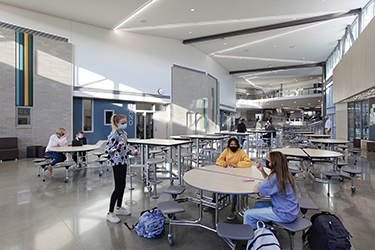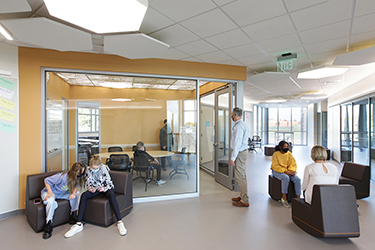|
Subscribe / Renew |
|
|
Contact Us |
|
| ► Subscribe to our Free Weekly Newsletter | |
| home | Welcome, sign in or click here to subscribe. | login |
Architecture & Engineering
| |
 |
February 24, 2022
Reimagining the middle school experience, even before the pandemic
NAC

McFadgen
|
Fundamental to the Glover Middle School culture is the importance for staff and administrators to meet students on their level, dedicating space and time to keep students in school, supporting them socially and emotionally while also keeping them on track academically.
If this culture was realized in a new building how could a new facility further enhance and support this student-centered approach? How could the built environment continue to elevate each student, allowing them to find opportunities for support and success?
The opportunity to answer these questions came to fruition when Spokane Public Schools planned to replace three outdated middle schools, including Glover, along with adding three new middle schools as part of the successful 2018 bond. One district-wide goal of the bond was to incorporate sixth graders into the historical seventh and eighth grade only middle school model.
This unique opportunity to reimagine the middle school experience came to life with the opening of Glover Middle School in the fall of 2021.
A PLACE FOR EVERYONE
A wide variety of spaces offer students the opportunity to find the spaces that are right for them throughout the day. Whether that space is an overlook into the commons, an open, more social learning stair for larger interactions, or outside in the student play areas, there is a place for everyone to find what they need to reflect and recharge. The planning and design of Glover continually reinforce a sense of discovery and inclusion, sparking curiosity and truly reflecting the unique neighborhood and surrounding community.
DISCOVERY
In early planning discussions the concept of discovery resonated with the design committee and became the core planning element. The committee galvanized around the concept that the building needed to spark a sense of exploration for every student. To encourage students to explore and connect with various programs throughout the school, windows are strategically placed to provide glimpses into all academic, student support, and outdoor learning environments. This glimpse may be all that is needed for a student to take the next step in engaging in a new activity or seeking the support that they may not have previously had the courage to take.
The sense of discovery for students begins immediately when they enter the school. Students and visitors move through the student plaza, with large rocks interspersed with seating areas into the main commons. Entries are scaled to create comfortable experiences for middle school students and their families — reinforcing the importance that everyone is welcome and encouraged to engage with the Glover students and staff.
The building developed aesthetically from the Bowl and Pitcher within Riverside State Park immediately west of the middle school. Students move through the school on a central path, similar to how the Spokane River meanders through the rock formations at the Bowl and Pitcher. On the path, students navigate around brick volumes that house learning areas with dark textured brick similar to the local basalt boulders, and lighter brick reflecting the warmth and light from the forest utilized to tie the building more closely to the local context and natural features.
Throughout the student commons, specialty classroom spaces, such as art, music, and technology, allow students to observe a variety of activities, possibly even piquing their interest to participate in programs they may not have explored otherwise. As students move through the building, small huddle rooms, and larger open gathering areas are sprinkled throughout the path, encouraging students to connect and gather together, while also allowing staff the ability to passively supervise and observe the students.
Central to the transition from the public areas to the core academic spaces, a ramp integrated with undulating platforms creates spaces for students to sit, eat lunch, and come together for formal instruction, performances, and assemblies.
Students can also opt to move beyond the ramp into the open learning commons, designed for a quieter experience with lower ceilings, quickly accessible technology and furniture more conducive to individual or small group activities. At this key transition space within the building, where every student will walk throughout the day is the counseling center — a welcoming space with easy access to encourage students to connect with support services available to them.
Continuing to draw upon nature, natural light is prevalent throughout the building. The shape of the building was deliberate to continually provide views to the outdoors, connecting the students to what’s happening beyond the building walls. An internal courtyard brings light into spaces deep within the building and serves as an outdoor learning environment.
ACADEMIC NEIGHBORHOODS
The six academic neighborhoods branch off of the learning commons and house the core academic spaces such as English, history, and math, along with a learning suite outfitted for science. Each room is connected to a central collaboration space with operable walls. Glass allows the neighborhoods to be connected visually when acoustical separation is needed and allows for a variety of options for teaching and group activities with the classroom spaces not limited to the traditional room size.
Connection and creating a sense of community in a variety of scales are key to the design and were specifically important in the neighborhoods. Creating small communities within the neighborhoods that are unique yet part of the larger Glover school community. Shared space within the neighborhoods allows for more personal one-on-one relationships while also minimizing travel time for students between classes. This translates into more time for learning while fostering opportunities for continued academic, social, and emotional interaction and support.
ACCESSIBLE SERVICES
Throughout the school, counselors and administrators are located within close access and proximity of students. During the planning and design effort, it was critical to remove all physical or perceived barriers for students to receive their support — this includes aspects such as incorporating middle-school appropriate play structures in the student plaza area. The student plaza, various courtyard spaces near the commons, and learning commons, along with playfield areas, encourage students to engage in physical activity and provide learning environments beyond the building walls. These outdoor spaces also serve as community amenities, which were previously not available within the Glover neighborhood.
An additional feature and critically important component to the Glover culture is the Family and Community Resource Center. Located at the main entrance, the FCRC provides meeting space for families and outside organizations independent of the administrative suite. This space can provide additional support to families and be discreetly used for food and clothing distribution. The shared room supports the whole child and family to ensure their basic needs are met so the student can truly focus on academics and realizing their full potential.
The reimagined Glover Middle School fully realized the opportunity to discover a new way to deliver middle school education and support communities. The building exemplifies the student-centered culture of the Glover staff and administration, enhancing their ability to strengthen that culture and truly deliver experiences that foster both unconditional belonging and access for generations to come.
“We want to look at middle schools through the lens of student,” said Greg Forsyth, Spokane Public Schools director of capital projects. “When we look at middle school now, we want to bring up the long-term relationships that the elementary school staff and students have and not push down a feeling of racing to finish high school starting in middle school. We need our students and staff to look at their learning in a new collaborative way.”
Mark Lund, principal of Glover Middle School, said: “Our focus was to ensure that each space creates a sense of unconditional belonging and access for all students. At every turn we asked ourselves, ‘How do we make sure students feel connected and truly noticed?’”
Melissa McFadgen, a principal at NAC Architecture, has dedicated her 23-year career to designing educational facilities, including nearly 50 Pre-K through grade 12 schools and has presented throughout the U.S. on educational facility design.
Other Stories:
- Meet Solera: where mixed-income meets mixed-use meets family time
- Redefining offices to inspire confidence
- The benefits of implementing BIM coordination
- The evolution of hyper-local community spaces
- Holistic Heroes: Lighting designers use efficiency and modeling
- A new perspective on structural fire safety is here





